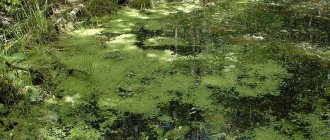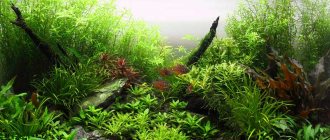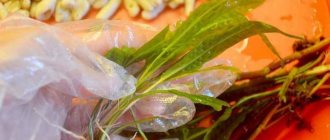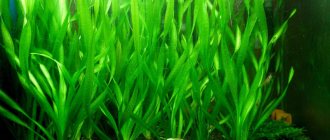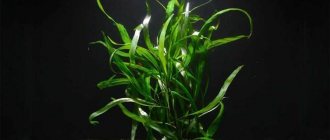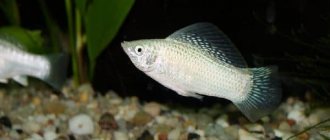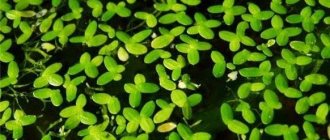When choosing plants for your home aquarium, you always want a combination of beauty and unpretentiousness. Sometimes this is difficult to achieve, because most plants in nature live in areas of long daylight hours and nutrient-rich waters. But in nature everything is perfectly balanced and exists successfully. Try to increase the daylight hours in the aquarium, and immediately everything will begin to become overgrown with weed algae. We have selected the most unpretentious and uncomplicated plants. Of course, among their species diversity there are also more demanding specimens, but most of them are easy to maintain and tenacious. If you follow a number of basic rules, they will decorate your home underwater world!
Anubias
Anubias are one of the most unpretentious aquarium plants belonging to the Araceae family. In nature, Anubias are found both in coastal zones and in the water bodies of equatorial Africa, and these can be either swamps with standing water or fast streams. A distinctive feature of Anubias is its creeping rhizome and dense, fleshy, rich green leaves. Aquarists value anubias for their vitality, hard “inedible” leaves, slow stable growth and the ability to grow these plants to snags and other decorations.
For Anubias, water of medium hardness and acidity with a temperature range of +22...+27 degrees is comfortable. The lighting is preferably not bright, dim.
Plants of different colors
To give the aquarium sophistication and uniqueness, you can use plants with foliage of different colors.
Suitable, for example:
- Echinodorus;
- alternatera;
- red pinnate;
- Valisneria tiger;
- hygrophila brown;
- Ludwigia Rubin;
- proserpinaka palustris.
But in order for these plants to maintain their bright and beautiful color, they require good lighting and nutrition.
Red pinnate
Hygrophila brown
Ludwigia Rubin
Alternatera
Echinodorus
Valisneria tiger
Proserpinaka palustris
Microsorum
The Thai fern microsorum is very decorative and unpretentious. Its homeland is Southeast Asia. Microsorum has a creeping rhizome and thin, hard leaves. Thanks to their rhizoids, microsorums are perfectly attached to aquarium decorations. The fern grows very slowly, over time forming dense thickets of rich green color. Fish, as a rule, do not nibble the microsorum. This fern prefers acidic soft water with a temperature of +20...+25 degrees. The microsorum does not require bright lighting.
Hornwort
Hornwort is a plant of the same name family distributed throughout the world. Hornwort is very unpretentious and easy to maintain. It is a long-stemmed plant with dark green thin dissected leaves. Hornwort does not have real roots; it forms special rhizoid branches to attach to the substrate. This plant feels good both fixed in the ground and floating in the water column. Hornwort grows very quickly, forming dense, impenetrable thickets, ideal for sheltering fish and their fry. The plant requires regular thinning to maintain its decorative appearance in the aquarium.
The water is suitable for it with medium hardness and acidity over a wide temperature range of +18..+28 degrees. Hornwort does not require bright lighting.
How many plants do you need in an aquarium?
Beginners in aquarium keeping may have difficulty determining the number of plants for the tank. To avoid mistakes and create an underwater forest in which fish cannot move freely, algae are planted at a distance of 3-10 cm, depending on the type and size. Over time, they will grow, and the planting density will become optimal.
Java moss
An unpretentious plant that, in favorable conditions, forms a thick head. Bright green shoots of moss are located close to each other and form beautiful thickets. Fry and small fish can hide in them. It’s easy to place a plant in an aquarium: just put a little moss on the bottom. Over time it will grow and occupy a larger area. To prevent the aquatic organism from being carried away by the flow of water from the filter, it is tied to a stone or snag.
Unpretentious aquarium plants: Java moss
Riccia
It lives on the surface and is a swimming species. Forms a good place for hiding fry and small fish from larger relatives. Riccia is not picky about the composition of water and can survive in the harshest conditions. And in a favorable environment, it can cover the surface with a dense green mat, blocking the access of light to the bottom. To reproduce, it is enough to place a small shoot in the aquarium.
Thailand fern
These are slow-growing algae that thrive in warm conditions. In a cold aquarium, their growth slows down or stops. Ferns do not need frequent replacements. Loves soft water, like in old reservoirs. The fern is shade-tolerant, but grows well in bright, diffused light. For an aquarium of 100-120 liters, 1-2 plants are enough.
Thailand fern
Indian fern
The conditions of its maintenance are similar to the care of the Thai fern. The plant should be disturbed as little as possible after planting; it does not take root well in a new place. It is better to place the fern on a snag or large stone, wrapping the rhizome with fishing line. Over time, the fern will cover the support with its roots and will hold itself to the bottom. The bush grows slowly.
Cladophora
It has the shape of a ball, reaches 10-12 cm. 3-5 such plants can be placed in an aquarium. They reproduce easily, breaking into pieces when they reach their maximum size. Algae prefer cool water; in warm water their growth stops. The hydrobiont is able to clean the reservoir of contaminants, acting as a filter.
Unpretentious aquarium plants: Cladophora
key moss
In nature it easily adapts to difficult conditions, but in an artificially created environment it is whimsical. The temperature for keeping moss in winter and summer is different: in winter – no higher than +12°С, and in summer – no lower than +26°С. The water should be clean and soft.
Moss floats in the aquarium and can be carried away by the current from the filter. To prevent this from happening, the plant is attached to stones or snags.
Vallisneria
One of the persistent and unpretentious hydrophytes. Survives in the harshest conditions: with a lack of light and nutrition, in polluted water overpopulated with fish. It grows quickly, so 3-5 copies are enough for thickets to form in 2-3 months. It is better to place it at the back wall of the reservoir .
Vallisneria
Hornwort
These algae are not planted in the ground because they do not have roots. The plant can simply be placed in an aquarium or attached to stones or driftwood. Hornwort is unpretentious and grows quickly, so you should not place more than 2-3 branches in a container. There is no need to create special conditions.
Nayas
Another unpretentious plant. It is not demanding on environmental parameters, but grows better in fresh water of moderate temperature. It develops quickly, stretching mainly upward. It is not necessary to fix the nayas in the substrate.
Unpretentious aquarium plants: nayas
Elodea
A rapidly growing aquatic organism capable of displacing other plants from an artificial reservoir. Not picky about living conditions. But he himself is able to purify water by absorbing fish waste products from it.
The amount of elodea in the aquarium must be regulated by periodically removing excess shoots.
Kabomba
Good algae for beginners. They do not require special care and can please you with their rapid growth and decorativeness. To make their foliage look beautiful and well-groomed, you only need to monitor the cleanliness of the water in the tank. Fish excrement, settling on green branches, affects the appearance of the kamomba.
Kabomba
Limnophila indica
It has lush beautiful shoots. It is better to grow the plant in large containers, since it can reach a length of up to 50 cm. To ensure that the branches do not lose their decorative appearance, good lighting is maintained in the aquarium.
The water must be filtered and replaced with fresh water at least once a week.
Bacopa carolina
Suitable for small aquariums and paludariums. The water should be clean and not too hard. In good light and warmth, bacopa grows quickly, forming a dense clearing of strong elastic stems. It is better to place it in the middle ground.
Unpretentious aquarium plants: bacopa carolina
Cirrus
There are many varieties, most of them are not demanding in terms of living conditions. The plant tolerates polluted water and poor lighting. But deteriorating conditions will affect the appearance of the algae.
Ludwigia
Found in aquariums for both beginners and experienced aquarists. It has certain requirements for its conditions of detention, without which it will not survive. These algae love warm water and good lighting. In dim light, their stems become elongated and their leaves become smaller. Ludwigia responds positively to mineral supplements.
Alternanters
This type of algae can be classified as demanding. They are sensitive to acidity and purity of water. Regular fluid changes and soil cleaning are required. In good conditions at a consistently warm temperature, the plant has an average growth rate and high decorative value.
Anubias
Popular among aquarists since the middle of the last century. It grows slowly, producing no more than one leaf per month, but it is not picky about conditions. It can successfully develop in the shade of other plants and does not lose its decorative properties in either soft or hard water. But Anubius is often attacked by protozoan algae, so the aquarium must be kept clean.
Duckweed
This plant most often appears in the tank by accident. Tiny duckweed leaves floating on the surface are transferred from aquarium to aquarium along with fish or other plants. The algae is tenacious and can be difficult to remove.
Schisandra
A beautiful plant with elongated leaves. Loves warm, soft water, which needs regular changes and filtration. An important factor for growth is bright lighting with a predominantly red spectrum. Schisandra requires good nutrition, the soil must be silted. Fertilizing with mineral fertilizers will not hurt. Algae occupy most of the tank, so 1-2 plants are enough per 100 liters.
Schisandra
Rotala
Characterized by uniform growth throughout the year. Requires a temperature not lower than +24°C, clean and soft water. Cloudy can cause the death of the plant. Bright lighting is the key to healthy development and lush branching of shoots. Single rotals look ugly . For a decorative effect, plant 5-10 plants together.
Staurogyne repens
A persistent and hardy aquatic organism. Capable of absorbing large amounts of nitrates from water, helps maintain cleanliness in the aquarium, which is beneficial for fish. Staurogin is distinguished by its compact appearance, not exceeding 10 cm in height, so it should be placed in the foreground in small groups. It is demanding on lighting; if it is lacking, it loses its decorative effect. Responsive to the supply of carbon dioxide and fertilizing.
Staurogyne repens
Marsilia
A ground cover plant, it is distinguished by its decorative appearance and slow growth. Requires clean water, which cannot be achieved without good filtration and regular cleaning of the substrate from excrement. Algae tolerate poor lighting. The appearance of Marsilia improves with the application of nitrogen fertilizers.
Cinema
One of the most unpretentious and beautiful hydrobionts, it can be recommended even to a novice aquarist. Blue does not need to be planted in the ground; it can develop by floating in the water column or on its surface. It is not demanding regarding the parameters of its habitat: it tolerates both poor lighting and irregular care.
Naiad
Nice seaweed for the background. They develop quickly, forming thickets. Not demanding on water parameters. They grow with a lack of light and nutrients, as well as in polluted and unkempt reservoirs. But you shouldn’t expect bright foliage when there is a lack of lighting. It is not necessary to plant the naiad in the substrate; it can be left floating freely or pressed to the bottom with a stone.
Echinodorus
It is impossible to talk about this plant as one, since there are many types of them and each has its own characteristics. Most are hardy. The tough leaves and stems look good for a long time even in unfavorable conditions.
Limnobium
A plant floating on the surface that develops quickly and can shade most of the aquarium. Loves bright light and is not picky about other parameters. Capable of purifying water from harmful substances.
Limnobium
Sitnyag
These algae are difficult to classify as unpretentious. In poor lighting they stretch out, and if the water is polluted they can die. Beginners are recommended to grow tall types of plants (for example, Sitnyag needle).
Hydrocotyla
An unpretentious aquatic organism that is only demanding about the cleanliness of the aquarium. Lighting, hardness and acidity do not play a special role. The plant is most often planted in the foreground or background, allowing it to branch freely.
Heleocharis
These algae do not like warm water; in hot weather it will have to be cooled. It tolerates the conditions of a paludarium or greenhouse better. In the aquarium, the water level should be low and the lighting should be bright.
Cryptocoryne
Quite hardy, can live in old water, tolerates shading and is not demanding on cleanliness and feeding. It receives food from sludge, so it is not advisable to clean it often.
Cryptocoryne Wendt
Arrowhead
A marsh plant found in its natural environment. It takes up a lot of space in aquariums, so it is not suitable for small tanks. The conditions of detention are not demanding.
Krinum
Large tall plant for large aquariums. Not all types of crinum are unpretentious; many of them need clean water with a weak current and good lighting. The plant needs a fine substrate.
Echinodorus
Echinodorus belongs to the Chastukhov family. The homeland of these plants is America. Different types of Echinodorus can differ greatly from each other both in size (from 5-10 cm to 1 meter), and in the shape of the leaves and their colors. All of them are very decorative and loved by aquarists. The voluminous, spectacular bushes of Echinodorus serve as a real decoration for aquariums.
Most Echinodorus are unpretentious plants that adapt to various water conditions. They love soft water with a temperature range of +24..+30 degrees and bright lighting (1 watt/liter). Echinodorus develop a powerful root system and are responsive to the application of root fertilizers.
Cryptocorynes
There are a huge number of species of cryptocorynes, and most of them are unpretentious, do not require strong light and grow quickly. But all cryptocorynes need to be planted in gravel - they have a powerful root rosette.
All cryptocorynes prefer to grow in hard water, but this is not a necessary maintenance condition. They are also all prone to cryptocoryne disease - they can dissolve in water. Still, even if this happens, it is enough to leave the plant alone, and it will probably recover.
Cryptocoryne yellow, becqueta (petcha), shiny, aponohetofolia, curly, and related are distinguished by especially rapid growth. Cryptocorynes reproduce by underground shoots and can quickly fill the available space.
Elodea
Elodea is a common and unpretentious plant of the aquatic family. It is found in nature on almost all continents (except for the northern zones). Elodea has long stems with small, fleshy, deep green leaves. The plant does not form roots, but is held in the soil by special rhizoids. Aquarists love Elodea for its rapid growth, undemanding nature and unattractiveness to herbivorous fish. Perfect for decorating the back wall of an aquarium. Young fish like to hide in dense thickets of Elodea. Water of medium hardness and acidity with a temperature of +20...+28 degrees is suitable for it.
Hygrophila loosestrife
Hygrophila willow is a plant with a long stem and long narrow leaves, similar in shape and length to willow leaves. Propagated by cuttings, after planting in the ground it forms quite powerful roots. This large plant takes up a lot of space, and when it reaches the surface, the leaves float, shading everything below. Therefore, it is recommended for decorating large aquariums.
Although hygrophila takes root in the soil, nutritious root feeding is not necessary; neutral gravel can be used.
Duckweed
Duckweed is distributed throughout the world and consists of small green leaves floating on the surface of the water, from under which thin roots extend into the water. Duckweed reproduces very quickly, filling the entire surface of the aquarium. On the one hand, this negatively affects the light entering the aquarium and the growth of other plants. On the other hand, fish fry, especially viviparous fish: guppies, swordtails, and mollies, feel cozy and safe under the duckweed. In addition, herbivorous fish happily feed on duckweed.
Water of medium hardness and acidity with a temperature of +18 to +30 degrees is suitable for duckweed.
How to choose?
The issue of choice is especially difficult for beginners to navigate. If only because at the moment more than 400 species of underwater plants are available for keeping in Russia.
Before making a choice, based, for example, on the appearance or cost of a living decoration, you need to take into account a number of other factors:
- Volume and depth of the aquarium. Some species are adapted to life only in small tanks, others - in large ones. The size of the plant itself does not always indicate preferences.
- Water temperature. In addition to unpretentious greens, there are species that feel good within certain temperature limits.
- Chemical composition. Vegetation reacts differently to acid and alkaline levels, as well as to the freshness of the water.
- Amount of light. Plants must be compatible with each other and other inhabitants in light preferences, namely in the amount of lighting and its duration.
- Species compatibility with fauna. To avoid complete consumption of vegetation by other living organisms or poisoning of fish, it is worth considering the compatibility of all potential inhabitants of the aquarium. For example, some cichlids can even tear out those plants that are firmly attached to the ground by their roots.
In addition to biological descriptions, you need to remember the appearance. This knowledge will help you determine whether the representative in front of you is healthy or not. It is necessary to pay attention to the aquarium and the plants that live and reproduce in it. It is important that the purchased sprouts develop in good conditions before this.
Cryptocoryne
Cryptocorynes are bush plants of the Araceae family. They are found naturally in tropical Asia in rivers and streams, as well as along their banks. Cryptocorynes differ from each other in leaf size, shape and color. Most cryptocorynes are quite unpretentious and adapt well to aquarium conditions. All of them are responsive to fertilization and, in the absence of fertilizing, can lose color and leaf size. Cryptocorynes do not need bright light; they prefer slightly alkaline water of medium hardness with a temperature of +24...+28 degrees.
A well-groomed cryptocoryne bush will serve as a real decoration for your home underwater world. In addition, fish practically do not chew cryptocoryne leaves, which makes them even more desirable in the aquarium.
Care
Unpretentious plants require simple care:
- water change;
- pruning overgrown branches;
- removal of rotting and damaged parts;
- application of fertilizers.
Partially change the water and thin the plant once a week. Do not replace large amounts of water unless necessary; it is enough to fill up to 25% of the aquarium volume. Combine fluid changes with soil siphoning. Siphon the soil carefully near the roots, using special small nozzles so as not to damage the plants. Apply fertilizer as needed, no more than once a month. Be careful with dosages.
Typically, unpretentious flora does not require additional fertilizing; green plants are sufficiently nutrient-dense in the water. Monitor the light intensity and color spectrum. When using fluorescent lamps, change them on time.
Java moss
Java moss has long been in demand among aquarists. It is loved for its unpretentiousness, interesting appearance, fast growth and the ability to be widely used in decorating an aquarium. The homeland of moss is Southeast Asia. Java moss is a plexus of long thin stems with small leaves of a rich green color. Moss does not form roots; it clings to the substrate and porous surfaces with the help of rhizoids. Growing very quickly in the aquarium, moss forms dense thickets that serve as spawning grounds for fish and shelter for young animals.
Java moss can grow under almost any conditions in an aquarium, the main thing is to observe the temperature regime (+22..+28 degrees) and lighting mode: it can withstand bright light or light partial shade.
Vallisneria
Vallisneria is one of the most common aquarium plants. It is found in water bodies all over the world in tropical and subtropical latitudes. Vallisneria has long, thin leaves attached to a short stem with a creeping rhizome. The color of the plant is rich green. Vallisneria is perfect for planting in the background of the aquarium, forming a dense “wall”. It is undemanding and fast-growing. Responsive to the application of fertilizers and the addition of carbon dioxide to water. Comfortable for her is soft, slightly alkaline water with a temperature of +23...+28 degrees.
Cirrus roraima
A very beautiful long-stemmed aquarium plant of brown-red color. The stems can reach 1 meter in length. Cirrus roraima is recommended for starting a new aquarium - it begins to grow immediately. This decorative look is also used in aquatic designs.
Propagated by cuttings and bushes well, forming side shoots. Creates a beautiful contrast with green plants.
Bolbitis
Bolbitis are ferns found in rivers and along their banks in tropical Africa. Bolbitis are distinguished by a rigid stem with small dark green leaves. The rhizome is creeping. Bolbitis grows very slowly, does not like bright light, like all ferns, and does not like the presence of suspension in the water. You should not bury the fern rhizome into the ground: it will rot and the plant will die. It is ideal to attach bolbitis to driftwood or stones - this way the plant looks very impressive. Bolbitis love soft, acidic water in the temperature range of +22 ... +27 degrees. Responsive to the supply of carbon dioxide to water.
© Aqua Logo Evgeniya Stepanova
Fields marked with * are required.
Adviсe
- Plant long-stemmed species in bunches of several pieces, so the vegetation will look more impressive.
- Secure mosses and ferns to driftwood and rocks.
- Beginners who have no experience in using fertilizers use ready-made general-purpose fertilizers.
- When planting bushes, leave a distance of 10 cm between them. It will take some time to fill the gaps.
- Greens brought from natural bodies of water will rot in a warm water reservoir. Before being placed in a community aquarium, the flora must acclimatize for a long time in a separate container. Increase the temperature gradually.
- Rinse the newly acquired vegetation with running water. Disinfect the twigs in a 1% solution of alum diluted in a liter of water for 5–10 minutes.
- Place fast-growing and light-loving plants in the most illuminated part of the vessel.
- For faster flowering of the flora, place it as high as possible. Then it will sooner emerge from the water and bloom.
Aquascaping has long been recognized as an applied art. Unpretentious and diverse plant species allow novice aquarists to get into aquascaping quickly and easily.
(Visited 358 times, 1 visits today)
